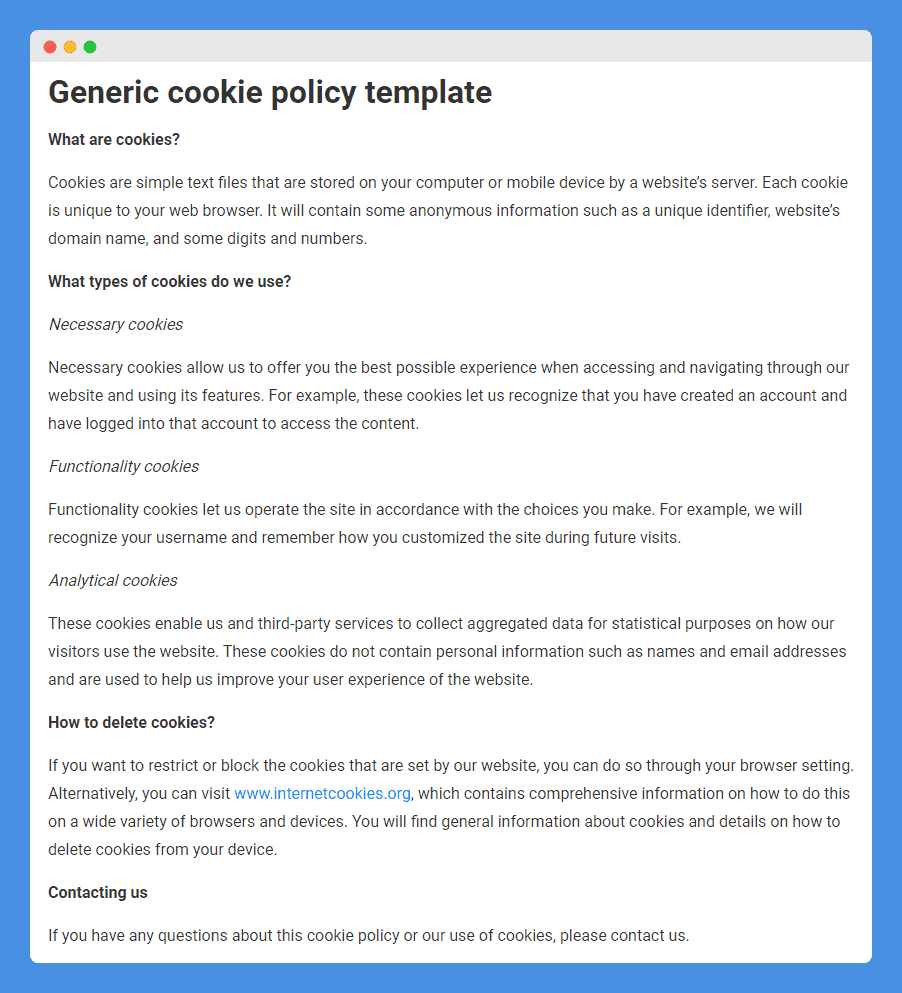
Cookies are small text files stored on a website visitor’s device to help improve their browsing experience. And if you own a website, it’s important to be transparent about its use. This is where a cookie policy comes in.
A website cookie policy is a legal document that discloses your use of cookies on your website. It outlines the purpose of these cookies, whether for website functionality or analytics and marketing.
Without these cookies, certain website features might not function properly. Now, the challenge lies in creating a comprehensive cookie policy that’s clear, informative, and keeps your store on the right side of the law.
For that, I’ve prepared a free cookie policy template and gathered real-world examples from which you can learn. I’ll also walk you through the key components to include in one so you can write your own.
KEY TAKEAWAYS:Table of Contents
PRO TIP: Don’t waste your time and take the guesswork out of the legal jargon with this personalized cookie policy generator trusted by over 200,000 businesses.
When it comes to how you should word your cookie policy, there is no standard formula or language, but the free cookie policy template below is a good starting point that you can adapt to your business and the cookies that you use.

While legal compliance is a crucial aspect of cookie policies, it shouldn’t be the sole focus. Imagine a customer visiting your online store for the first time. They’re bombarded with a dense legal document filled with jargon about cookies.
It’s overwhelming and doesn’t exactly inspire confidence.
Our user-friendly cookie policy generator takes the legalese out of the equation and helps you create a clear, concise, and informative cookie policy that your customers will actually understand.
It guides you through a series of simple questions about the cookies your website uses. This could include session cookies for shopping carts, analytics cookies to track website traffic, or advertising cookies to personalize user experiences.
Based on your selections, the generator builds a customized cookie policy template that outlines the types of cookies used, their purpose, and how users can control their cookie preferences.
Using the generator, you can create a document that informs your customers, complies with regulations, and strengthens your brand image – a win-win for everyone!
Several privacy laws around the world mandate that websites disclose their use of cookies. Here’s a rundown of the key regulations regarding cookies that you need to be aware of:
While a cookie policy isn’t universally mandated by law, several key privacy regulations require them for websites operating within their jurisdiction.
A well-crafted policy should not only inform users that cookies are used but also clearly outline the types, their purpose, and most importantly, how users can provide consent before placing cookies on their devices.
What exactly should you include to ensure it’s both comprehensive and user-friendly? Here are 11 key components that will help you create an effective and transparent cookie policy for your store:
When crafting your cookie policy, it’s important to specify the different categories of cookies being used on your website. This helps users understand the variety of cookies they might encounter.
For instance, your website might use site performance cookies, functionality cookies, and targeting cookies. The goal here is to be transparent about the types of cookies visitors may encounter while browsing your online store.
This section should explain what cookies are being used for, either to enhance the user experience and/or to operate your website. Here are some of the most common types and their purposes:
PRO TIP: Due to the collection of potentially sensitive data, ask for user consent to place cookies. Doing so may also be required by regulations like GDPR and CCPA.
This section should go beyond simply listing cookie categories and purposes. Explain how the information collected through cookies benefits both your website and your customers.
While some users might be hesitant about cookies, a survey revealed that 32% of Americans “agree directly” to cookies when they understand the value they provide.
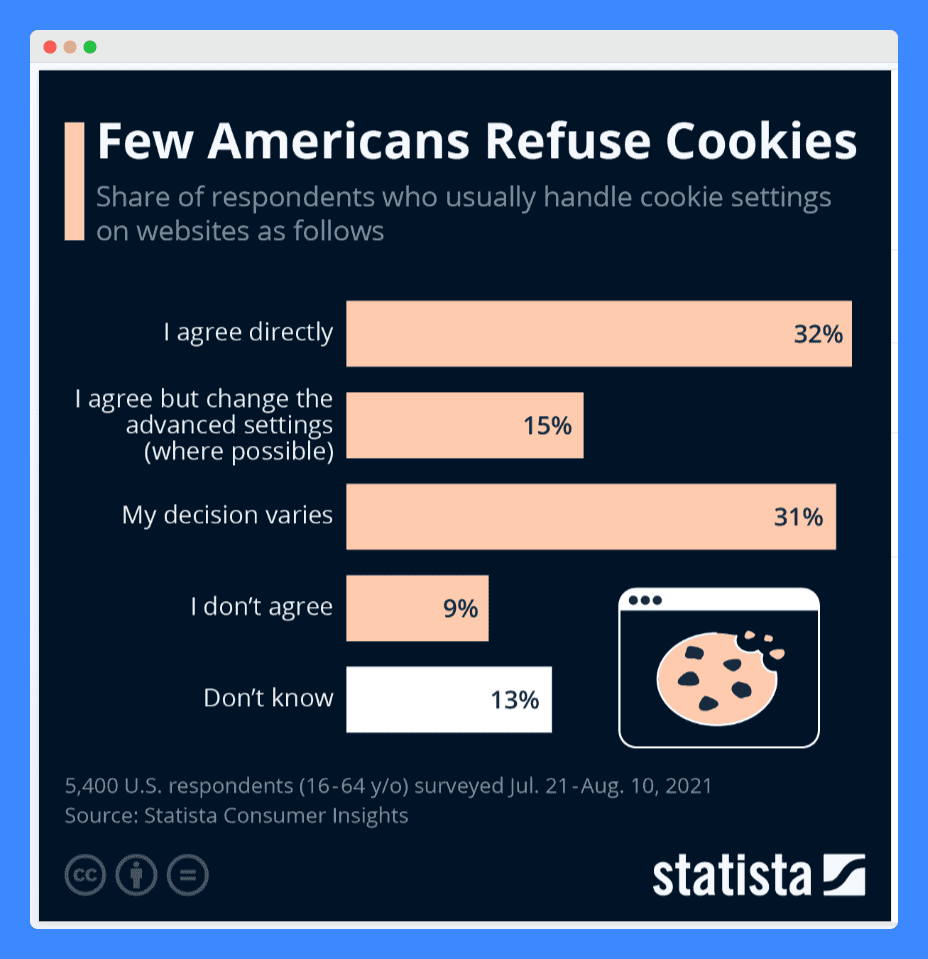
When you explain how cookies can also personalize their experience, improve the site’s performance, and offer targeted recommendations, you can encourage more visitors to accept them.
Detail the methods used to gather data, such as tracking user interactions, recording browsing patterns, and storing user preferences. Being transparent about these methods in your cookie notice text can significantly benefit your business.
How so? Clear communication helps build trust with your customers, as they feel more informed and in control of their data. This can increase the customer’s confidence in your brand, potentially boosting retention and loyalty.
With growing concerns about online privacy, users are increasingly cautious about the data they share online. This section should address those concerns by clearly outlining the specific types of information stored within the cookies on your website.
When you’re transparent about this, you demonstrate your commitment to responsible data practices. You show site visitors they can trust you with their data, encouraging them to feel comfortable providing consent for your cookies policy.
PRO TIP: To ease their worries, emphasize that you only collect and store information relevant to the functionality of your website or to provide a personalized user experience.
Website cookies have expiration dates too, and explaining this in your cookie policy is important. Explain that there are two main types of cookies based on storage duration.
Session cookies only last as long as the visitor’s browser window is open and are automatically deleted once they close it. Persistent cookies, on the other hand, have a longer shelf life. They stay on their device for a predetermined period (hours, days, or even years) depending on their purpose.
By outlining the lifespan of each cookie category, you give your visitors control. They’ll understand how long their information is stored and can make informed decisions about their cookie preferences.
These cookies are placed on a user’s device by a domain different from the one they’re visiting. This happens when a website integrates elements from external sources. The third-party server that places these cookies can then track user behavior.
For instance, if your website embeds a YouTube video, YouTube might set cookies to track user behavior on your site related to the video.
To show transparency, it’s important to define what third-party cookies are and how they differ from first-party cookies (which your website directly places). You’ll also want to outline their purposes, such as social media sharing functionality or targeted advertising based on browsing history.
This section should provide clear instructions regarding cookie preferences. For example, you can outline the different ways users can manage cookies on your website, such as:
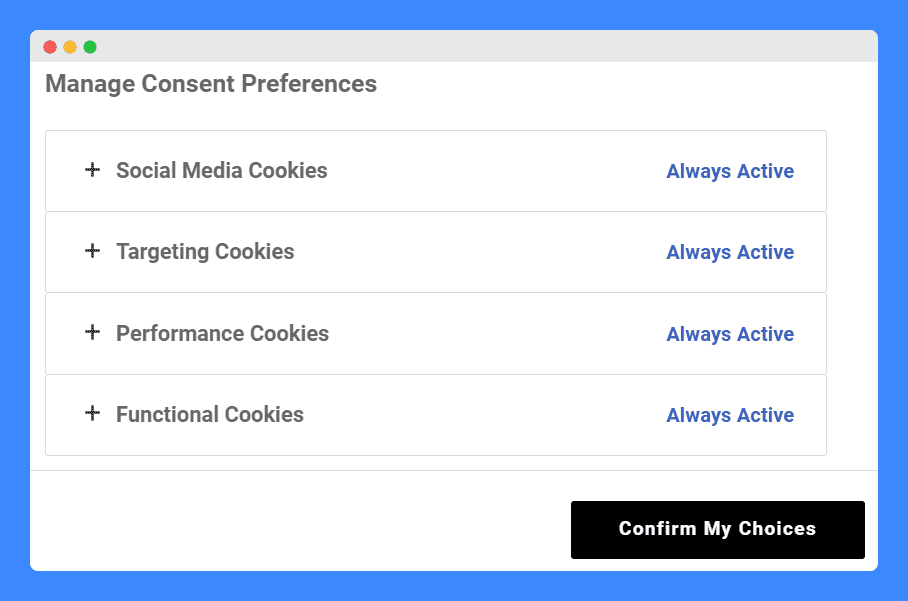 on various website cookies tab on a white background." width="908" height="601" />
on various website cookies tab on a white background." width="908" height="601" />
Inform your users that most web browsers offer settings to manage cookies. They can typically choose to block all cookies, delete existing cookies, or be notified before a cookie is placed.
While you can’t directly control browser settings, cookie settings to acknowledge this option demonstrate transparency and empower users to take control of their cookie preferences beyond your website.
While transparency about user control is important, it’s also helpful to explain the potential drawbacks of disabling cookies altogether. Explain that certain features might be limited or unavailable, hindering the ability to personalize the user experience.
For example, essential cookies enable core functionalities such as keeping users logged in or remembering items in a shopping cart. Disabling these cookies can lead to a less seamless and less personalized browsing experience.
“If there’s one reason we have done better than most of our peers in the Internet space over the last six years, it is because we have focused like a laser on customer experience, and that really does matter, I think, in any business.”
That said, the goal here isn’t to scare users into accepting cookies. Instead, provide balanced information so they can make informed decisions.
Users appreciate knowing their information is protected and that they’ll be kept informed of any changes to how cookies are used on your website. So, in this section, inform them about how you’ll handle changes to your cookie practices or the policy itself. This could involve:
PRO TIP: Consider including a line encouraging users to review your cookie policy periodically for any updates. This empowers them to stay informed about how their information is being used.
Offer a clear and accessible way for users to reach out with any questions or concerns about your cookie practices. Include an email address, phone number, or a contact form link dedicated to privacy-related inquiries.
By offering a direct line of communication, you reassure them that their privacy is a priority and that you are available to address any issues or uncertainties they might have.
To make sure your visitors are fully informed about your cookie policy, you need to display it prominently on your website. Here are effective spots where you can place your cookie policy to maximize visibility and compliance:
The first strategic location to display your cookie policy is in the website footer. This is a commonly used spot because the footer is typically present on every page of your website and easily accessible to users.
You can see this approach implemented on the Good American website, where the cookie policy link resides within the footer navigation:

By placing it here, Good American ensures it’s readily available for users who want to learn more about how cookies are used on its site.
If you place yours here, visitors scrolling down to the bottom of any page can quickly find a link to your cookie policy page alongside other important legal documents like privacy policies and terms of service.
Another excellent spot to display your cookies policy is on a dedicated cookie policy page. This approach allows you to provide detailed information about your cookie practices in one comprehensive location.
For example, Gymshark’s website has its own Cookie Policy page, where users can find extensive information about the types of cookies used, their purposes, and how to manage them:
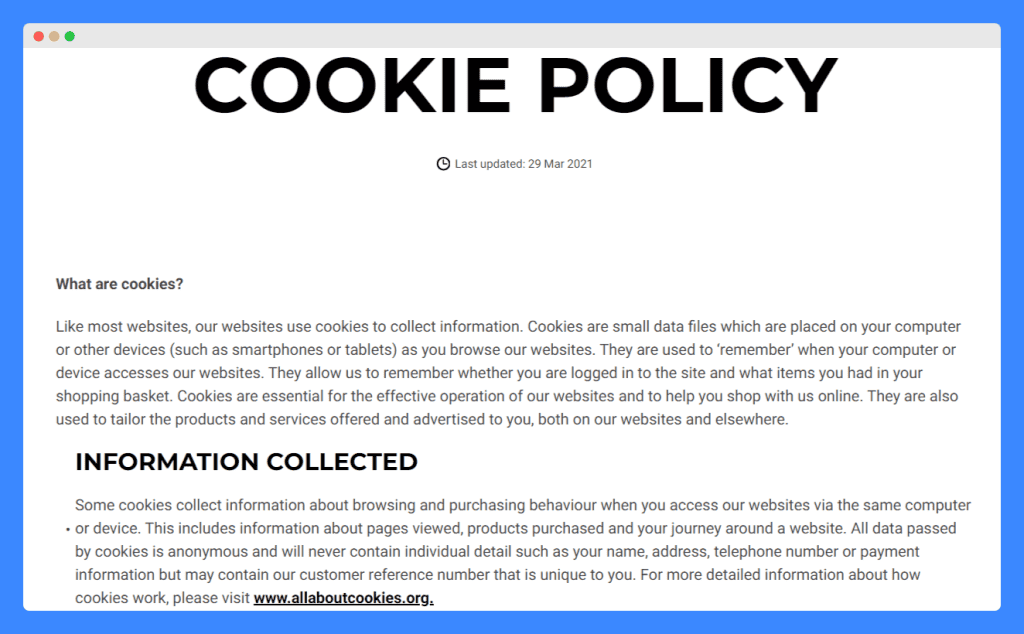
Having a dedicated page means Gymshark demonstrates transparency and provides a user-friendly experience for visitors seeking information about how their data is handled.
Including your cookie policy within your general privacy policy page is another effective method. This approach ensures that all privacy-related information is consolidated in one place, making it easier for users to find and understand your data practices.
For example, MUJI’s website features a cookies section within its general privacy policy page:
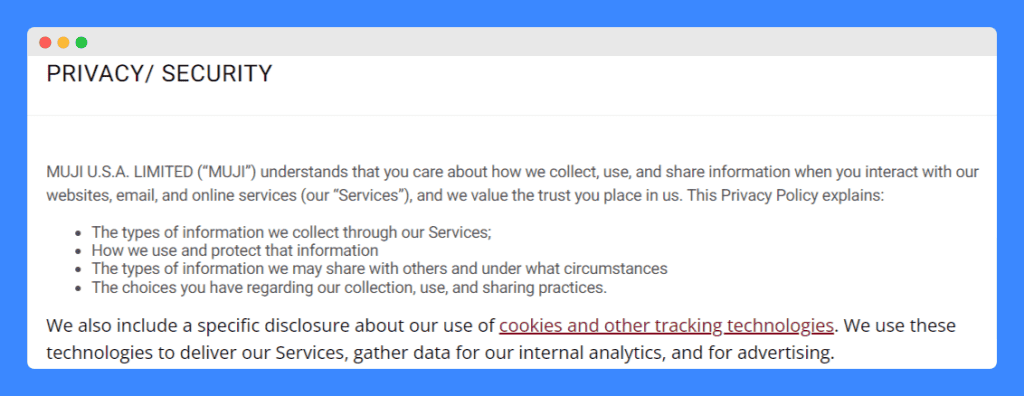
This section not only explains their cookie usage but also includes a link to the cookies policy for more detailed information.
By embedding a link to your policy within the privacy policy, MUJI provides a seamless and user-friendly way for visitors to access comprehensive privacy and cookie information.
This eye-catching notification appears immediately when a user visits your website, making it hard to miss.
One of the best cookie banner examples I came across is the pop-up on Waterdrop’s homepage. The banner clearly states that cookies are used to enhance the user experience and offers a button to visit the site’s Cookie Settings.

The cookie banner text should be concise and informative, explaining that cookies are used and providing a clear link to your full cookie policy for further details. You can also include options for users to accept or manage their cookie preferences directly within the banner.
You should update your cookie policy whenever there are significant changes to the cookies used on your website or how you use the information collected through them. This ensures your policy remains accurate and reflects your current data practices.
Here are some tips for updating your cookie policy:
Regularly updating your policy shows you are committed to protecting user privacy and respecting their data preferences. Doing so not only ensures you remain compliant with privacy laws and regulations but also promotes confidence in your website.
To help you create a clear and compliant cookie policy, it can be valuable to look at how other successful websites handle their cookie notices.
By examining these cookie notice examples, you can gather insights into effective ways to communicate your cookie practices and ensure user understanding.
Plant Therapy provides an excellent example of a well-structured cookie policy. Firstly, it has a dedicated cookie policy page, ensuring that users can easily find detailed information about their cookie practices:

The policy also explains what cookies are in simple, user-friendly language, making it easy for visitors to understand. It even mentions the different cookies the website uses, providing transparency and clarity:
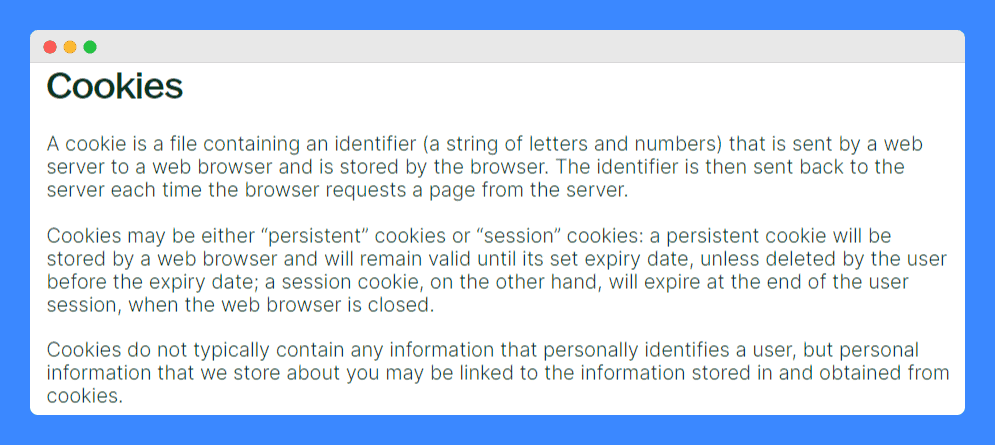
Using a list, the policy clearly outlines the reasons why the website uses cookies, such as improving website functionality, enhancing user experience, and facilitating marketing efforts:
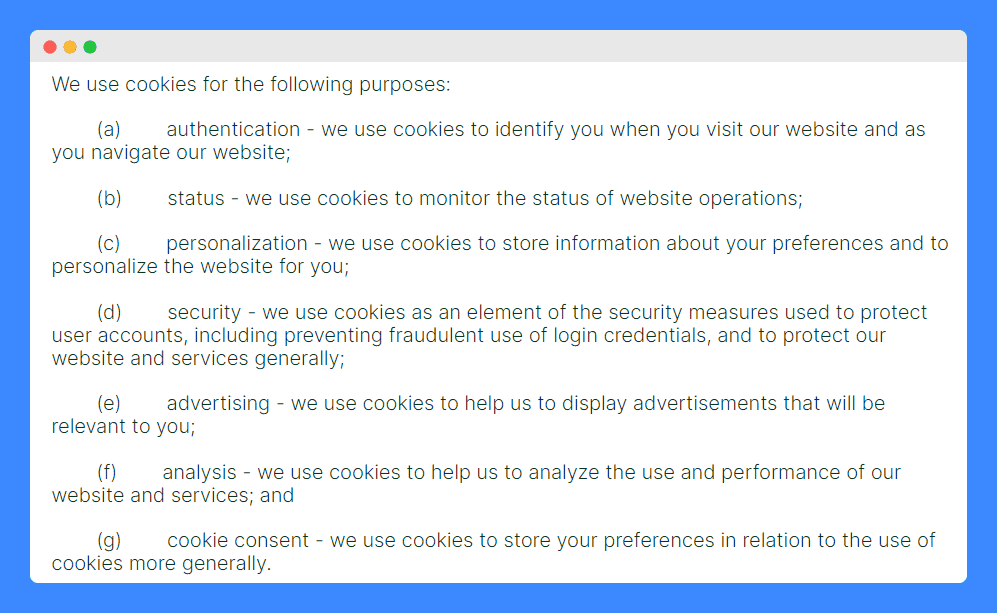
Lastly, the policy discusses the cookies used by its service providers, giving users a comprehensive view of all third-party cookies involved:

By covering these aspects, Plant Therapy’s cookie policy not only ensures compliance but also promotes trust with its users through clear and transparent communication.
True Leaf Market provides another great example of an effective cookie policy. Their privacy policy includes a dedicated cookies section that explains what cookies are and what they’re used for.

This section not only informs users about their options for managing cookies but also clearly communicates the potential impact on site functionality if cookies are disabled.
By including these elements, True Leaf Market’s cookie policy ensures users are well-informed about their choices and the implications of those choices.
Trove Brands’ privacy policy includes a dedicated section called “Cookies and Other Similar Technologies,” where cookies are thoroughly discussed.
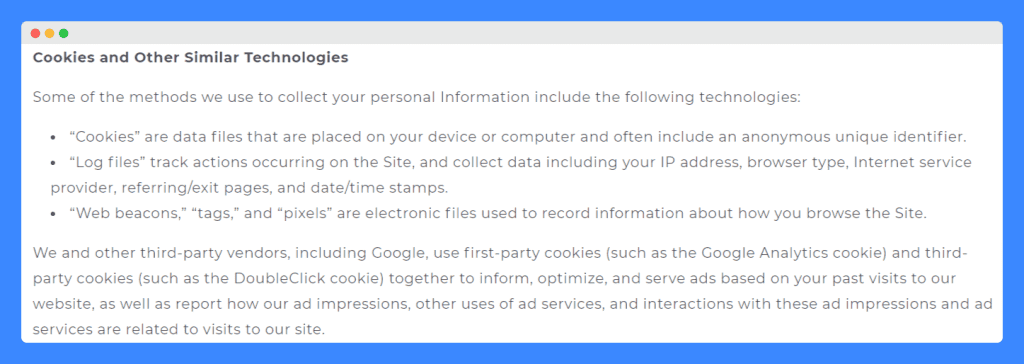
This section lists some of the methods used to collect personal information, providing transparency about data collection practices.
It also explains the difference between first-party and third-party cookies and describes what each type is used for, helping users understand the various entities involved in data collection.
Another section of the policy describes the types of cookies used on the website and outlines the user’s options for managing these cookies, ensuring users are informed about how to control their cookie preferences:
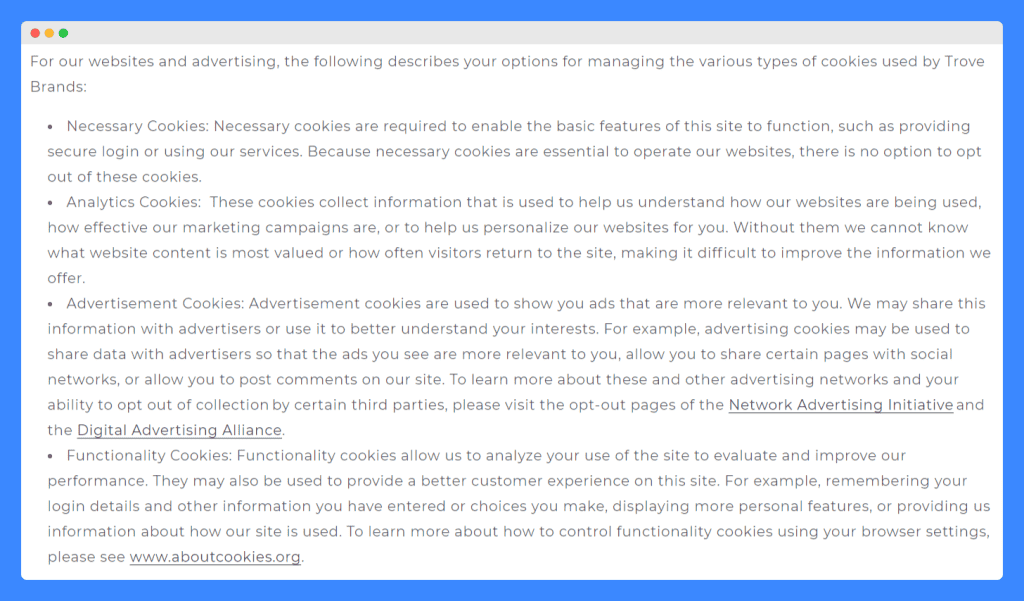 outlining the types of cookies they use on their website." width="1024" height="601" />
outlining the types of cookies they use on their website." width="1024" height="601" />
Like the previous examples, Prom Girl includes a dedicated Cookie Section within its Privacy Policy. It features a table that categorizes the different types of cookies used on the site and explains why these cookies are necessary, providing clear and organized information.
 outlining the types of cookies their website use and why." width="1024" height="732" />
outlining the types of cookies their website use and why." width="1024" height="732" />
Immediately after the table, there is a list of options for users to control or limit how the site and its partners use cookies and similar technologies. This empowers users to manage their cookie preferences effectively.

Prom Girl’s approach is an excellent example of cookie policy transparency, combining clear explanations with practical user controls to enhance understanding and trust.
At the bottom of the homepage, Hill House Home displays a pop-up cookie banner that asks users to accept or reject cookies. This immediate interaction ensures users are informed about cookie usage from the moment they visit the site.

The banner includes a Cookie Settings button that redirects users to the site’s Privacy Preference Center. Here, users can learn more about the types of cookies the site uses and make informed decisions about their cookie preferences.

Boston Proper’s cookie policy effectively informs and reassures users about their data privacy and site functionality:
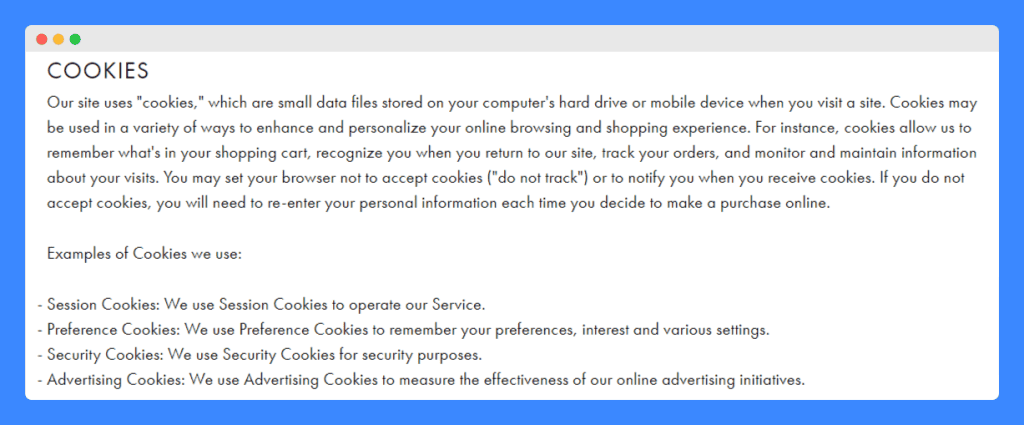
It informs users about their options for managing cookies, including setting their browser to not accept cookies (“do not track”) or to notify them when they receive cookies. This empowers users to make informed choices about their data.
The policy also lists examples of cookies used on the site, categorizing them into Session Cookies, Preference Cookies, Security Cookies, and Advertising Cookies. Each category is briefly explained, clarifying their purposes.
Vuori Clothing has its own Cookie Policy page that clearly explains what cookies are, how the site uses cookies, and why different categories of cookies are used. This ensures users understand the purpose and function of cookies on their website:

At the bottom of the page, there is a Contact Us section where users can reach out to Vuori Clothing for more information, providing an additional layer of transparency and support:

There is also a Cookie Settings button that, when clicked, redirects users to a pop-up where they can manage their cookie consent preferences. This user-friendly feature makes it easy for visitors to adjust their settings at any time:
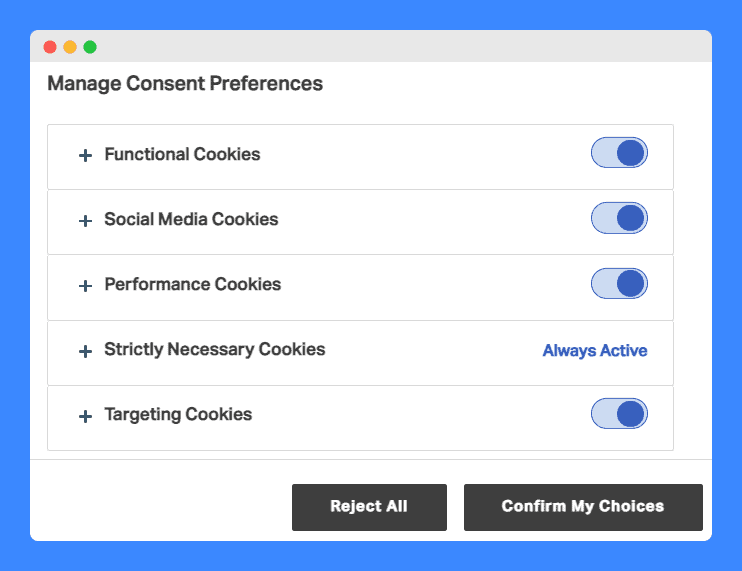 on various website cookies tab on a white background." width="742" height="571" />
on various website cookies tab on a white background." width="742" height="571" />
Freestyle USA’s Cookie Policy starts with a straightforward explanation of what cookies are. It then clearly states the purposes for which cookies are used, such as updating the site based on visitor data and tracking traffic patterns:
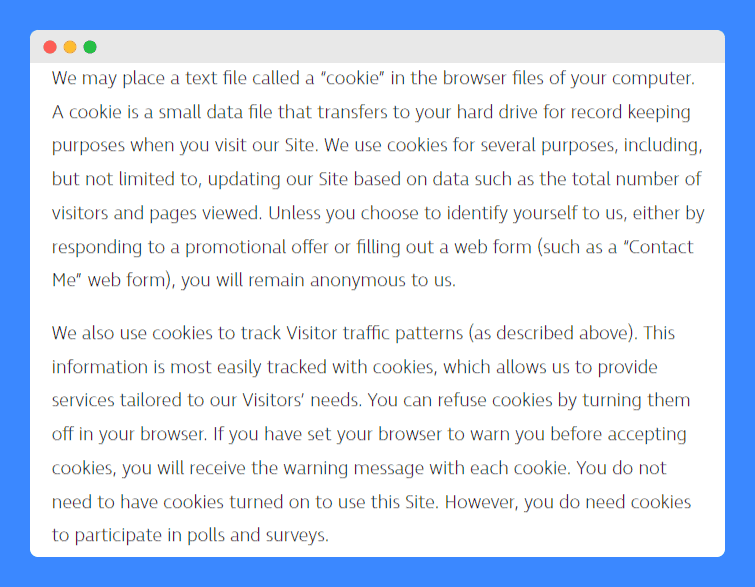
I like that the policy reassures users that they will remain anonymous unless they choose to identify themselves by responding to a promotional offer or filling out a web form.
Plus, it provides instructions on how users can refuse cookies by turning them off in their browser and explains the implications of doing so.
NuFACE’s cookie policy is highlighted within the Third-Party Pixels & Cookies section of their Privacy Policy page:

The section explains what third-party pixels and cookies are and what they are used for in simple, understandable language. This helps users grasp the concept and purpose of these technologies.
It also provides clear instructions on how users can manage their cookies, including preventing their browser from accepting new cookies, setting the browser to notify them when they receive a new cookie, or disabling cookies altogether.
Moreover, the policy addresses privacy concerns by explaining that these cookies do not contain personally identifiable information:

That said, it is honest about the fact that third-party business partners might combine cookie data with other information to identify a user’s email address or other details.
The Cookies and Similar Tracking Technologies section within Glossier’s Privacy Policy page briefly explains what cookies are and how the site uses them, making it easy for users to understand the basic concept and purpose of cookies:

It also mentions how third-party providers use cookies, offering transparency about external data collection practices.
The policy is linked to a pop-up where users can turn off cookie-based ad targeting, providing a user-friendly way to manage advertising preferences:

You need to have a cookie policy for your website to comply with privacy laws. It also ensures transparency about data collection and user consent.
Notify users about your cookie use and policy through a pop-up banner or a dedicated section in your privacy policy. Ensure it’s easily accessible from every page on your website.
A cookie policy details how cookies are used on your site and their purposes. A cookie consent notice informs users about cookies and seeks their permission before placing cookies on their devices.
Enforce a cookie policy by implementing mechanisms that require user consent before cookies are set. Provide options for users to manage their preferences.
Yes, many privacy laws like GDPR and CCPA require a cookie policy. It ensures transparency about data collection and usage, helping to comply with legal regulations and protect user privacy.
CIPP/E, CIPM, FIP, ECPC-B, LLMAndrea is a data protection and privacy specialist with many years of education and expertise in this area of law. She helps clients by ensuring compliance is reached on all levels while taking into account the legal requirements and their business' needs.

![]()
GET STARTED